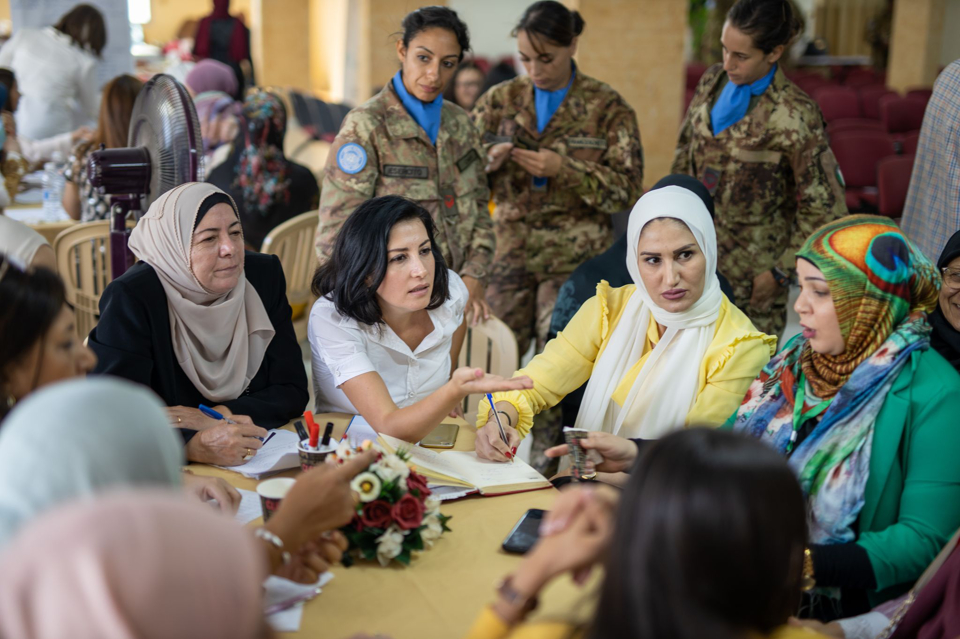As two Palestinian and Israeli women and friends, who have lived through longstanding antagonism of our nations, we have seen firsthand the devastating impact of war and hatred on both sides. We came together to share our belief that female leadership is crucial for a better future for both people. However, women have been largely excluded from peace negotiations, decision-making processes, and leadership positions. To overcome the barriers that exclude women from key roles, there must be a concerted effort by all stakeholders to create a more inclusive and gender-equal environment for peacebuilding.
The Security Council adopted Resolution 1325 in October 2000, which reaffirms the important role of women in the prevention and resolution of conflicts and peace negotiations. It stresses the importance of their equal participation and full involvement in all efforts, and urges all actors to increase women’s participation. Yet, more than two decades later, women are still largely excluded from peace negotiations and other critical decision-making processes.
Since the establishment of the Palestinian Authority in 1993, no woman has held main office positions (president or prime minister). In the current Palestinian cabinet, women hold 3 out of 26 ministerial-level posts (Minister of Women’s Affairs; Minister of Tourism and Antiquities; Minister of Health), representing a drop from 21% in the previous government to 11.5%.
In Israel, there are only 6 female ministers out of 31 ministers, and only zero female General Directors of the Ministries.
One of the only Israeli women who took part in the negotiations with the Palestinians is Tzipi Livni, who served as Israel’s Minister of Foreign Affairs 2006-2009 and was involved the Annapolis Conference in 2007. During 2013-2014 another round of talks was led by U.S. Secretary of State John Kerry, with Livni serving as the chief negotiator for the Israeli side. However, the talks ultimately collapsed without any agreement being reached.
The advantages of women
Women can bring a different perspective to the table when it comes to conflict resolution. Studies show that women are more likely to use a collaborative conflict resolution style and avoid conflict, which can lead to more creative and sustainable solutions. As collaboration is generally considered more productive in the conflict resolution process, the study suggests that women may possess more effective conflict resolution attributes than their male counterparts. Seeking solutions that benefit all parties involved can lead to more creative and sustainable solutions to complex issues, such as the ones we face.
Women are also less ego-driven, more empathetic, and more willing to recognize others’ pain and apologize. These are essential traits in building trust and understanding between conflicting parties. It is especially crucial in this matter, given the countless lives lost, number of dreams crushed, and innumerable tears shed. Women are often called upon to mediate disputes within their families and communities, and these skills can be leveraged in larger peace-building efforts such as this one.
Use case: Liberia
Women have successfully led nonviolent peace movements and achieved peace in places where their male counterparts have failed, such as Leymah Roberta Gbowee in Liberia. She successfully led the Women of Liberia Mass Action for Peace: a women’s nonviolent peace movement, that ended the Second Liberian Civil War after 14 years.
Many women found themselves carrying the burden of the war’s consequences – seeing their young sons forcibly recruited into the army, losing their husbands, and constantly feeling unsafe. They understood the need for nonviolent resistance and the tolerance and empathy needed to change the hearts and minds of those in power. The movement‘s success was due to four main factors: grassroots mobilization, nonviolent resistance, international support, and effective negotiation. Most of them are attributable to the unique ways women lead.
The movement was based on nonviolent resistance, which helped to ensure it wasn’t seen as a threat by the government or other armed groups. Their peace negotiation was successful because they were openly willing to compromise and make concessions, encouraging their counterparts to follow suit.
More examples are Rigoberta Menchu, an indigenous Guatemalan woman, Aung San Suu Kyi, a Burmese politician in Myanmar, and Tawakkol Karman, a Yemeni journalist.
Conclusion
There are still significant barriers that prevent women from fully participating in conflict resolution and peacebuilding, including gender discrimination, lack of access to education and resources, and cultural and social norms that limit women’s roles. To overcome these barriers, there must be a concerted effort by all stakeholders to address these challenges and create a more inclusive and gender-equal environment for peacebuilding.
Empowering women can be done in many ways, one of which can be by creating safe spaces for women to come together and share their life experiences, as we have done here at the Harvard Kennedy School.
Going forward, there are several recommendations that could be implemented:
- Recognize and address the structural barriers that prevent women from participating in peacebuilding. Provide systematic resources and platforms to secure access of diverse young women to mentorship and training opportunities in fields such as security and negotiation, to demonstrate from a young age that these are not fields dominated by men.
- Change public perceptions of women’s roles in these fields and challenge traditional gender stereotypes. Encourage the media to highlight women’s contributions in conflict resolution.
- Provide targeted funding and support for women-led peace and security initiatives.
- Foster partnerships between women-led initiatives and existing conflict-resolution or security organizations. By working together, women-led initiatives can access additional resources and expertise, while established manly organizations can benefit from the unique perspectives and experiences of women.
- Increase representation of women in formal peace negotiations and decision-making bodies.
In conclusion, promoting reconciliation is a challenging task that requires patience, willingness to listen, and understanding the “other side.” By empowering women to take on leadership roles in conflict resolution, significant progress toward a more peaceful future can be achieved.
